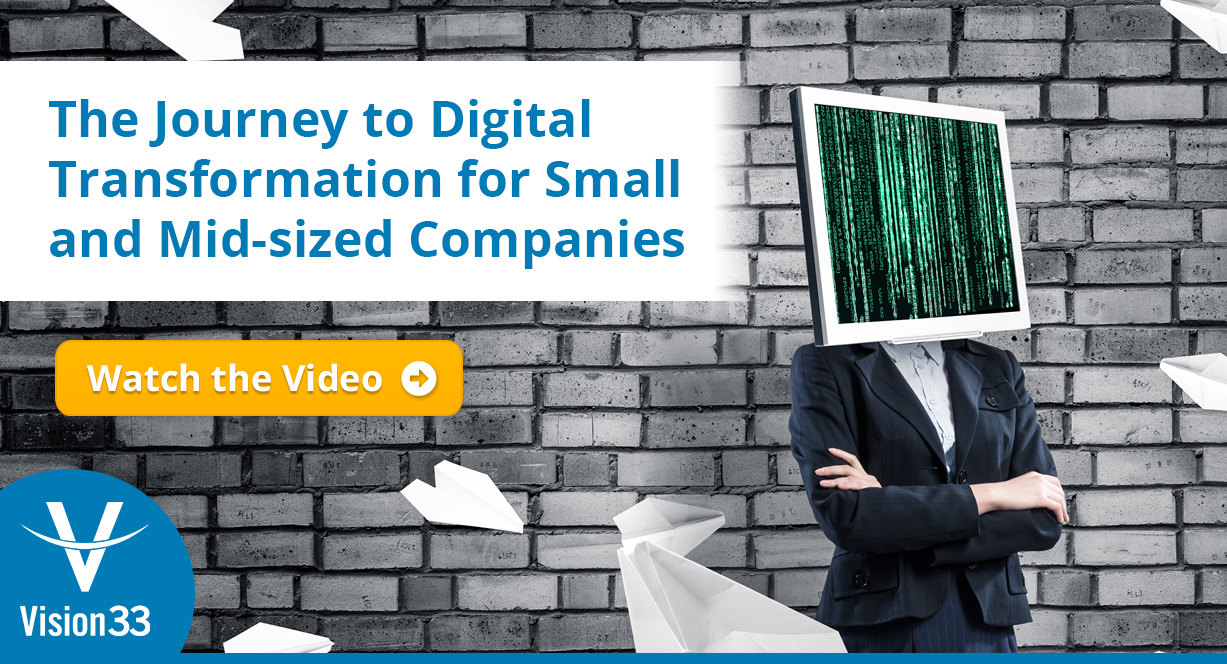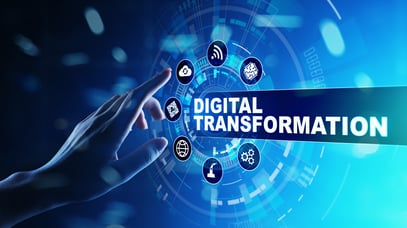Why Cloud ERP Is a Catalyst for Your Digital Transformation Journey
SAP S/4HANA Cloud, Public EditionWith a cloud ERP solution like SAP S/4HANA Cloud Public Edition as your core system of record,...

June 25, 2020
Blog > The Journey to Digital Transformation for Small & Mid-sized Companies
Half (48 percent) of you want to develop a digital transformation strategy for your business but haven’t done it yet. Who is you? Executives in companies with less than $500m in revenue. And if you’re part of the 52 percent with a defined digital transformation strategy, you’re likely trying to apply that strategy and adopt a new approach.
A large part of the challenge for mid-sized businesses is figuring out what the heck “digital transformation” means and reaching an agreement within your organization. Even for companies that say they’ve embarked on the journey, the language and understanding of the goal are often fuzzy. Then there are the challenges of figuring out how it applies to your situation, and how to effectively implement this transformation.
In this post, we’ll address these three areas – what digital transformation is, where to start for your situation, and effectively implementing a strategy – with a focus on small and mid-sized companies with less than $500 million in revenue.
 Many people use “digital transformation” as a shorthand for eliminating paper-based systems and spreadsheets. But digital transformation is so much more. Think of it in the broader context as using technology to create new – or modify existing – business processes, culture, and customer experiences. In today’s business environment, it’s never been more critical to reimagine how to do almost everything to meet changing business and customer requirements.
Many people use “digital transformation” as a shorthand for eliminating paper-based systems and spreadsheets. But digital transformation is so much more. Think of it in the broader context as using technology to create new – or modify existing – business processes, culture, and customer experiences. In today’s business environment, it’s never been more critical to reimagine how to do almost everything to meet changing business and customer requirements.
Andrew Annacone, managing partner at TechNexus Venture Collaborative, suggested four types of digital transformation:
• Business process – How you operate the functional business (e.g., taking payment by check or credit card).
• Business model – How you charge for value to your customer (e.g., selling a product versus offering it via subscription).
• Domain – The type of business you are and the type of businesses you compete with (e.g., a manufacturer of products vs. the designer of machines for manufacturers).
• Cultural/organizational – How you organize and manage people (e.g., results-oriented work versus traditional line management or in-office versus remote).
When most executives think about digital transformation, they think about business processes and how to reinvent them with software, analytics, machine learning, etc.
But digital transformation can also be about the business model and how you deliver value to customers. Consider a tool provider that shifts its model from sales to subscription. Rather than just shifting processes, this type of transformation shifts your positioning and value in your industry.
When developing a digital transformation strategy, many companies think they need to start with the culture/mindset. But that may be the hardest place to start because people are much more difficult to change than systems or processes. In the long term, the business culture must shift to a more agile and flexible approach – but starting there is fraught with potential failure.
Finally, as your company progresses on its digital transformation journey, you may uncover opportunities in adjacent or new markets where your transformed organization can compete as a non-traditional competitor. This is domain transformation as you enter a new competitive domain. One of the best examples is Amazon and Amazon Web Services (AWS). AWS probably wasn’t part of Amazon’s original business plan, but Amazon realized the expertise and systems they developed to run their business could also power other companies.
Small and mid-sized companies must consider two factors: limited financial and human capital resources and our rapidly changing business environment. For companies facing those issues, it’s best to define digital transformation as the process and cultural transformation for gaining the agility and flexibility to react to the market and your customers.
You’ll eventually want to consider layering in business model transformation if it makes sense in your industry or sector. For many businesses, transforming the business model along with processes and culture may be too much to absorb; even in large companies, many CIOs admit they’re optimizing business models with digital rather than creating entirely new business models.
 If you asked business executives in 2019 what was most important to them, many would have said they were concerned about missing growth opportunities. Six months into 2020, those executives are now concerned with basic business survival, resiliency, and flexibility. They want to find new ways of operating with fewer people and find new supply sources and different revenue sources.
If you asked business executives in 2019 what was most important to them, many would have said they were concerned about missing growth opportunities. Six months into 2020, those executives are now concerned with basic business survival, resiliency, and flexibility. They want to find new ways of operating with fewer people and find new supply sources and different revenue sources.
A logical place to start on a digital transformation journey is by identifying the gaps in your current business that cause fragility and rigidity. What information are you missing? Or, said differently, what information is so time-consuming to gather that you don’t bother because it’s out of date before you can use it?
Then consider which business aspects are people-dependent versus system-driven. For example, you may need people in your accounting department to process checks and collect on delinquent accounts. What would happen if you reimagined the process and only took electronic payments and changed your billing process to auto-draft payments from customers?
Or you may have gaps between systems that rely on people to plug the hole, such as needing people to export data to spreadsheets, manipulate it, and import it into another system. What if your ecommerce system automatically connected to inventory, shipping, and your CRM? Or your point-of-sale system automatically connected to inventory, which communicated directly with your suppliers? Imagine all those processes happening with systems instead of people and spreadsheets or reports.
Next, consider your customers. How do you want your digital transformation journey to benefit them? Maybe it’s a better customer service process or a customer self-service process. For companies that service equipment, maybe it’s performing preventative maintenance based on feedback from sensors installed at customer locations versus performing it on a schedule. Most companies start the journey thinking about the benefits to themselves, but quickly realize the competitive advantages they can gain by including their customers in the calculation.
Once you’ve identified your gaps and goals, write them down, get the team on board, and plan the timing.
As you document the gaps and goals, strive for specificity. What does the gap cost in terms of people and lost revenue? Is there an opportunity cost from your team filling or skipping gaps and not having time for more revenue-producing work?
Regarding the customer impact of your transformation, consider the possible competitive advantage. What’s that worth in terms of customer retention, the average value of a customer, and a reduction in sales costs because you need fewer customers to retain the same revenue?
To get this right, you need your team to pull information, imagine scenarios, and prioritize. And not just the executive team – your company will benefit from including front-line managers from the beginning.
Successful digital transformation occurs with an eventual cultural and mindset shift in how you operate. Engaging your front-line managers gives them a stake in the outcome. And if you have cheerleaders/business champions who aren’t managers, involve them, too.
Finally, don’t forget the money. This transformation will require systems, training, and probably some concessions to customers where you make mistakes before everything goes the way you want. Where’s the budget for these changes coming from and over what time?
Digital transformation is a journey, not a destination, and can only be accomplished gradually. Prioritizing your to-do list with consideration of systems, processes, and people and calculating each step’s possible costs will allow you to budget this investment over several years. The total cost will be substantial, but spreading it over years makes it possible.
 A system change spurs changes in processes and behaviors, so it’s logical to start by looking for alternative systems to fill the gaps you’ve identified and prioritized. Forty percent of technology spending will go toward digital transformations, with enterprises spending over $2 trillion through 2019, according to IDC.
A system change spurs changes in processes and behaviors, so it’s logical to start by looking for alternative systems to fill the gaps you’ve identified and prioritized. Forty percent of technology spending will go toward digital transformations, with enterprises spending over $2 trillion through 2019, according to IDC.
Your main system of record – accounting, older ERP, or order system – will probably need to be re-platformed to new technology. If you’ve been running your systems on-premises with a server in a closet, now is the time to look at cloud or off-site hosted options to reduce your technology capital expense. (You can get our ebook about cloud-based solutions here.)
You must also ensure that a new ERP or core business platform will integrate with every system you ultimately choose. Custom, single-point integrations are expensive to build and maintain and limit flexibility to change systems or adapt processes in the future. So, as you consider new systems, also evaluate the middleware or integration application you’ll use to connect them. Integration platform as a service (iPaaS) is a class of integration technologies that give you flexibility without sacrificing functionality. The Vision33 Saltbox Platform is an example of this.
As you evaluate the systems you’ll need to update, take a holistic view that includes the applications you need for your first steps on the digital transformation journey, and the additional applications you’ll want to tie to it in two or three years. This is time-consuming, so you may want to seek outside expertise. During this process, you’ll probably uncover needs or opportunities for adaptation that you didn’t consider in the planning process.
If you haven’t purchased a major business system recently, you can keep this process moving by engaging a full-time project manager (if you’re running this in-house) or retaining a firm to help with selection (if you’re outsourcing). If you outsource, your team must stay deeply involved – leadership and functional areas – so your choices align with your plan. (You can get our guide to selecting a new ERP solution here.)
During this process, you aren’t trying to do the same thing you’ve always done, only faster. Have your team members check their attitudes as they learn new approaches and methods of doing things. Everyone must be comfortable with being ignorant of what’s possible because it changes quickly. If you listen to the vendors you meet along the way, you’ll discover new best practices. This system change needs to spur process and behavior change – you’re seeking a transformation, and what got you here won’t get you to your new destination.
As you change systems, processes, and even value propositions to your customers, your leadership team and managers must manage the transition from old to new. Your employees have probably been comfortably doing their jobs well, so these changes will create resistance. And not because people don’t like change – we all like trying new things – but because your staff will likely feel somewhat incompetent in their “new” job. People will grieve for the old way of doing things. They’ll even grieve for woefully inadequate systems. And they’ll do so until they’re comfortable with the replacements. Managing Transitions by William Bridges is a great book on this topic.
This post discussed many aspects of digital transformation at a superficial level. In the past, making a change was typically driven by the goal of finding new business models for differentiation or significant margin, or finding new revenue streams. In today’s pandemic – and post-pandemic – world, it’s just as likely you’re considering sweeping changes based on how your customers are now interacting with you or as a result of your staff operating in new, decentralized locations.
Twenty-five years ago, the availability and cost of technology would have been enormous barriers for mid-sized companies to overcome. But no longer. SaaS models for applications, high-availability infrastructure like AWS, and the ability to find the expertise you need to make it work together change the technology equation for smaller companies. And your experience with remote work due to pandemic-forced flexibility has likely disrupted your staff’s status-quo, making them more open to change.
Fortune 500 companies have been on the digital transformation journey for five or more years. For small and mid-market companies, the time to catch up is now.
Subscribe to our newsletter to receive our latest blog posts, case studies and ERP news delivered straight to your inbox.
With a cloud ERP solution like SAP S/4HANA Cloud Public Edition as your core system of record,...
Why is it so difficult to manage bills of materials (BOMs)? Here are three of the most common bill...
Discover the power of AI in SAP S/4HANA Cloud. Explore the intelligent features and capabilities...
Recieve our latest blog posts, case studies, and ERP news
delivered straight to your inbox.